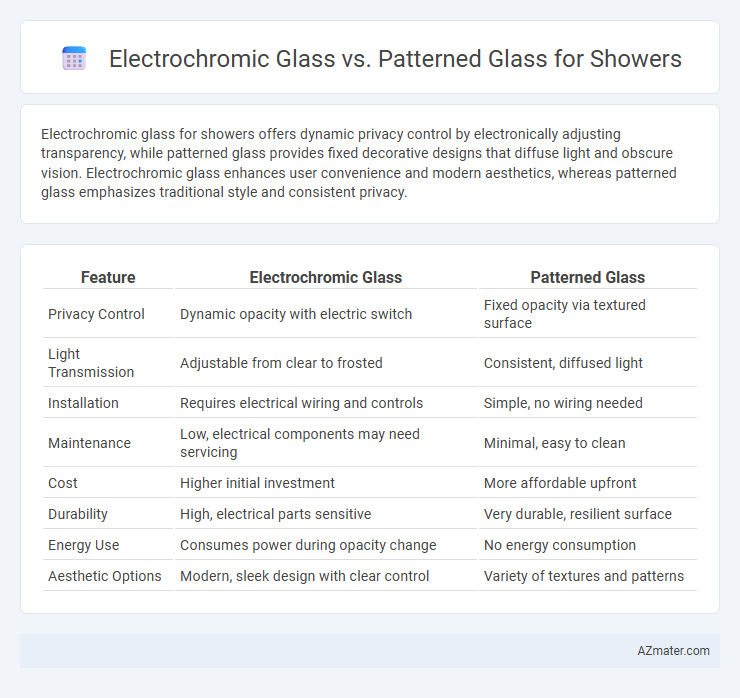Electrochromic glass for showers offers dynamic privacy control by electronically adjusting transparency, while patterned glass provides fixed decorative designs that diffuse light and obscure vision. Electrochromic glass enhances user convenience and modern aesthetics, whereas patterned glass emphasizes traditional style and consistent privacy.
Table of Comparison
| Feature | Electrochromic Glass | Patterned Glass |
|---|---|---|
| Privacy Control | Dynamic opacity with electric switch | Fixed opacity via textured surface |
| Light Transmission | Adjustable from clear to frosted | Consistent, diffused light |
| Installation | Requires electrical wiring and controls | Simple, no wiring needed |
| Maintenance | Low, electrical components may need servicing | Minimal, easy to clean |
| Cost | Higher initial investment | More affordable upfront |
| Durability | High, electrical parts sensitive | Very durable, resilient surface |
| Energy Use | Consumes power during opacity change | No energy consumption |
| Aesthetic Options | Modern, sleek design with clear control | Variety of textures and patterns |
Introduction to Electrochromic and Patterned Glass
Electrochromic glass offers dynamic privacy by adjusting transparency through an electric current, making it ideal for modern shower designs that require both openness and discretion. Patterned glass features textured or etched surfaces that provide static privacy by obscuring visibility while allowing light to pass, commonly used for traditional and decorative shower enclosures. Both options enhance bathroom aesthetics and privacy, with electrochromic glass providing innovative control and patterned glass delivering reliable, constant screening.
How Electrochromic Glass Works in Showers
Electrochromic glass in showers uses a thin film coating that changes opacity when an electrical current passes through it, allowing users to switch from transparent to frosted for privacy on demand. This smart glass technology is energy-efficient and controlled via a wall switch or mobile app, offering instant customization compared to permanently opaque patterned glass. By responding dynamically to user input, electrochromic glass enhances shower privacy while maintaining sleek, modern aesthetics.
The Technology Behind Patterned Shower Glass
Patterned shower glass is created through advanced techniques such as acid etching, sandblasting, or rolling textured patterns into molten glass, which enhances privacy and visual appeal without compromising durability. This technology allows for customizable designs that scatter light and obscure visibility, ensuring a balance between aesthetic style and functional privacy. Unlike electrochromic glass, patterned glass does not rely on electrical components, making it a low-maintenance and energy-free option.
Privacy Control: Electrochromic vs Patterned Glass
Electrochromic glass offers dynamic privacy control by instantly switching from transparent to opaque through an electrical charge, making it ideal for customizable bathroom environments. Patterned glass provides static privacy with textured designs that obscure visibility but lack adjustability. For showers, electrochromic glass outperforms patterned alternatives by delivering on-demand privacy without compromising natural light.
Design Flexibility and Aesthetics Compared
Electrochromic glass offers dynamic opacity control, allowing users to switch between transparent and frosted states for customizable privacy and modern design versatility in showers. Patterned glass provides a fixed decorative surface with etched or embossed textures, enhancing visual interest and obscuring visibility without electronic features. The choice impacts aesthetics significantly: electrochromic glass emphasizes sleek, high-tech adaptability, while patterned glass delivers timeless, tactile elegance.
Installation and Maintenance Differences
Electrochromic glass installation demands professional electrical integration and precise sealing to accommodate its smart tinting technology, while patterned glass requires only standard glazing techniques without electrical components. Maintenance for electrochromic glass involves careful handling of electrical wiring and occasional system checks to ensure functionality, whereas patterned glass needs routine cleaning to preserve its ornamental surface without specialized care. The complexity of installing and maintaining electrochromic glass results in higher upfront costs compared to the simpler, more cost-effective patterned glass options commonly used in showers.
Cost Analysis: Upfront and Long-Term
Electrochromic glass for showers features high upfront costs due to advanced technology and installation complexity, but offers energy savings through dynamic light and heat control, potentially lowering long-term utility bills. Patterned glass presents a more affordable initial investment with simple manufacturing processes, though it lacks energy efficiency benefits and may incur additional costs for privacy treatments over time. Evaluating total cost of ownership, electrochromic glass may justify its premium price through durability and operational savings, while patterned glass remains budget-friendly with minimal maintenance expenses.
Durability and Lifespan in Wet Environments
Electrochromic glass offers superior durability in wet environments due to its sealed, multi-layer construction that resists moisture infiltration and maintains performance over time. Patterned glass, while generally robust, can suffer from surface wear and etching because of its textured design, reducing its lifespan when exposed to constant humidity and water. The encapsulated technology of electrochromic glass enhances resistance to corrosion and prolongs functional life, making it more reliable for shower applications.
Energy Efficiency and Smart Features
Electrochromic glass in showers offers dynamic tinting controlled via smart home systems, significantly improving energy efficiency by regulating heat and natural light, thus reducing HVAC load. Patterned glass, while providing privacy and aesthetic appeal, lacks smart features and does not contribute to energy savings. The integration of electrochromic technology enhances both comfort and sustainability in modern bathroom designs compared to traditional patterned glass.
Which is Right for Your Shower?
Electrochromic glass offers customizable opacity with touch or remote control to provide privacy and light control in showers, making it ideal for those seeking modern, high-tech solutions. Patterned glass features etched or textured designs that diffuse light and obscure visibility, delivering a decorative yet straightforward option suitable for traditional or budget-conscious showers. Choosing between electrochromic and patterned glass depends on your preference for advanced technology versus classic aesthetic, as well as budget and maintenance considerations.

Infographic: Electrochromic glass vs Patterned glass for Shower
 azmater.com
azmater.com